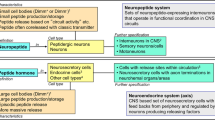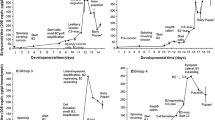Abstract
Ecdysteroids play an important role in the larval moulting process of insects. Ecdysone-induced stimulation causes specific “puffs” in polytene chromosomes of salivary gland cells resulting in nuclear swelling. During this process, changes of intracellular ion composition are thought to act as an early regulatory mechanism of gene activation. By use of video-imaging analysis and electrophysiological techniques, we examined ecdysone-induced nuclear swelling in Drosophila salivary glands in situ and its dependence on pH and calcium. Isolated glands of the third larval stage were superfused with a solution mimicking the haemolymph. Addition of 5×10−6 mol/l 20-OH-ecdysone led, after a lag period of 50 min, to a sustained Ca2+-dependent increase of nuclear volume by 23.0±2.3%. Amiloride, a blocker of plasma membrane Na+/H+ exchange, prevented 20-OH-ecdysone-induced nuclear swelling. Decreasing pH in the superfusate from 7.15 to 6.8 led to nuclear shrinkage by 16.9±3.9%. Measurments of pH in salivary gland cells with ion-sensitive microelectrodes disclosed an alkalinization of 0.23±0.05 pH units after stimulation with 20-OH-ecdysone. We postulate that 20-OH-ecdysone activates the amilorde-sensitive plasma membrane Na+/H+ exchanger. This leads to intracellular alkalinization and concomitant decondensation of the nuclear chromatin visible as nuclear swelling. Thus, cell alkalinization could be a potentially important stimulatory mechanism in mediating ecdysteroid-induced activation of the cell nucleus.
Similar content being viewed by others
References
Aerts RJ, Durston AJ, Moolenaar WH (1985) Cytoplasmic pH and the regulation of the Dictyostelium cell cycle Cell 43:653–657
Barry JM, Merriam RW (1972) Swelling of hen erythrocyte nuclei in cytoplasm from Xenopus eggs. Exp Cell Res 71:90–96
Beato M (1991) Transcriptional control by nuclear receptors. FASEB J 5:2044–2051
Berendes HD, Ashburner M (1978) The salivary glands. In: Ashburner M, Wright RF (eds) The genetics and biology of Drosophila, vol 2B. Academic Press, London, pp 453–481
Blackmore PF, Beebe SJ, Danforth DR, Alexander N (1990) Progesterone and 17-hydroxyprogesterone J Biol Chem 265:1376–1380
Chegini N, Lei ZM, Rao CV (1991) Nuclear volume and chromatin conformation of small and large bovine luteal cells: effect of gonatropins and prostaglandins and dependence on luteal phase. Cell Tissue Res 264:453–460
Clever U, Karlson P (1960) Induktion von Puff-Veränderungen in Speicheldrüsenchromosomen von Chironomus tentans durch Ecdyson. Exp Cell Res 20:623–626
De Loof A (1986) Tissue specificity of steroid hormone action. A new theory. Insect Biochem 16:169–173
Dworniczak B, Seidel R, Pongs O (1983) Puffing activities and binding of cedysteroid to polytene chromosomes of Drosophila melanogaster. EMBO J 8:1323–1330
Felsenfeld G (1992) Chromatin as an essential part of the transcriptional mechanism. Nature 355:219–2245
Guo X, Cole RD (1989) Chromatin aggregation changes substantially as pH varies within the physiological range. J Biol Chem 264:11653–11679
Hodgetts RB, Sage B, O'Connor JD (1977) Ecdysone titers during postembryonic development of Drosophila melanogaster. Dev Biol 60:310–317
Jäger S, Wijchmann J, Kremer J (1990) Studies on the decondensation of human, mouse, and bull sperm nuclei by heparin and other polyanions. J Exp Zool 256:315–322
Karlson P (1963) New concepts on the mode of action of hormones. Perspect Biol Med Winter 1963:203–214
Kimura M, Gardener JP, Aviv A (1990) Agonist-evoked alkaline shift in the cytoplasmatic pH set point for activation of Na+/H+ antiport in human platelets. J Biol Chem 265:21068–12074
Kröger H (1966) Potentialmuster und Puff-Muster. Elektrophysiologische und cytologische Untersuchungen an den Speicheldrüsen von Chironomus thummi. Exp Cell Res 41:64–80
Leake RE, Trench ME, Barry JM (1972) Effect of cations on the condensation of hen erythrocyte nuclei and its relation to gene activation Exp Cell Res 71:17–26
Lezzi M, Richards G (1989) Sanvary glands. In: Koolman J (ed) Ecdysone. Thieme, Stuttgart, pp 393–406
Maruyama Y, Ptersen OH, Flanagan P, Pearson G (1983) Quantification of Ca2+-activated K+ channels under hormonal control in pig pancreas acinar cells. Nature 305:228–232
Oberleithner H, Weigt M, Westphale H-J, Wang W (1987) Aldos-terone activates Na+/H+ exchange and raises cytoplasmic pH in target cells of the amphibian kidney. Proc Natl Acad Sci USA 84:1464–1468
Pouyssegur J, Franchi A, G'Allemain L, Paris S (1985) Cytoplasmic pH, a key determinant of growth factor induced DNA synthesis in quiescent fibroblasts. FEBS Lett 190:115–119
Przywara DA, Bhave SV, Bhave A, Wakade TD, Wakade AR (1991) Stimulated rise in neuronal calcium is faster and greater in the nucleus than in cytosol. FASEB J 5:217–222
Robb JA (1969) Maintenance of imaginal discs of Drosophila melanogaster in chemically defined media. J Cell Biol 11:376–385
Schumacher M (1990) Rapid membrane effects of steroid hormones: an emerging concept in neuroendocrinology. Trends Neurosci 13:359–362
Spelsberg T, Goldberger A, Hora L, Horton M, Littlefield B (1987) Characterization of the nuclear binding sites (acceptor sites) for a steroid receptor. In: Roy A, Clark JH (eds) Gene regulation by steroid hormones, vol 3. Springer, Berlin Heidelberg New York, pp 25–32
Wang W, Messner G, Oberleithner H, Lang F, Deetjen P (1984) The effect of ouabain on intracellular activities of K+, Na+, Cl−, H+ and Ca2+ in proximal tubules of frog kidneys. Pflügers Arch 401:6–13
Wührmann P, Inneichen H, Riesen-Willi U, Lezzi M (1979) Change in nuclear potassium electrochemical activity and puffing of potassium-sensitive salivary chromosome regions during Chironomus development. Proc Natl Acad Sci USA 76:806–808
Author information
Authors and Affiliations
Rights and permissions
About this article
Cite this article
Wünsch, S., Schneider, S., Schwab, A. et al. 20-OH-ecdysone swells nuclear volume by alkalinization in salivary glands of Drosophila melanogaster . Cell Tissue Res 274, 145–151 (1993). https://doi.org/10.1007/BF00327995
Received:
Accepted:
Issue Date:
DOI: https://doi.org/10.1007/BF00327995




